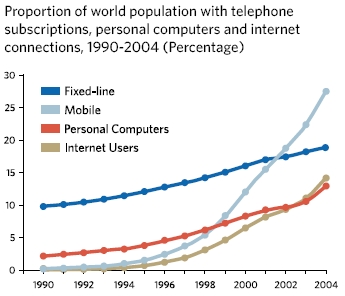The Millennium Development Goals Report 2006 has just been released and the main conclusion is “well… errrr… we’ve not accomplished almost anyhting… some things have indeed worsened… but, hey, let’s give a positive and optimist message that there’s some change to move into the right path”.
Concerning ICT’s and ICT4D it is evident that, actually, there’s an increasing adoption of these technologies at all levels:

Proportion of world population with telephone subscriptions, personal computers and internet connections, 1990-2004 (Percentage). Source: Millennium Development Goals Report 2006
But I’m “glad” to read that:
[there is] a large digital divide separating developed and developing
regions: Over half the population in developed regions had access to the Internet, compared to 7 per cent in developing regions and less than 1 per cent in the 50 least developed countries.
Of course I’m not “glad” to read that there is a digital divide, but that at least someone recognizes it exists and, regardless of the fact that in relative terms the divide has decreased, in practical terms it is so huuuuuuge that shame on you for sticking to righteous-and-oh-so-formally-correct statistical data interpretation. This is something I wrote about in my post World Telecommunication/ICT Development Report 2006: digital divide narrowing?
and feel comforted to see that I’m not the only one looking at it this way.
If you need to cite this article in a formal way (i.e. for bibliographical purposes) I dare suggest:
Peña-López, I. (2006) “The Millennium Development Goals Report 2006: ICT and Digital Divide target” In ICTlogy,
#34, July 2006. Barcelona: ICTlogy.
Retrieved month dd, yyyy from
https://ictlogy.net/review/?p=416
Previous post: Course on the Digital Divide
Next post: World Information Society Report 2006 and Digital Opportunity Index 2006
1 Comment to “The Millennium Development Goals Report 2006: ICT and Digital Divide target” »
 RSS feed for comments on this post.
TrackBack URI
RSS feed for comments on this post.
TrackBack URI

 The Millennium Development Goals Report 2006
The Millennium Development Goals Report 2006
Pingback: ICTlogy » The 2007 e-readiness rankings: comments and critiques